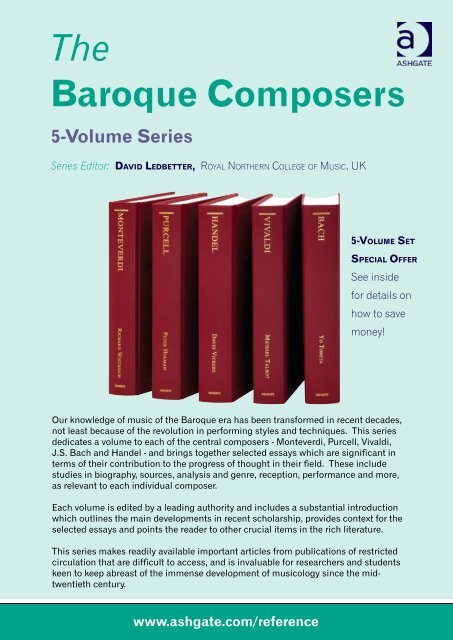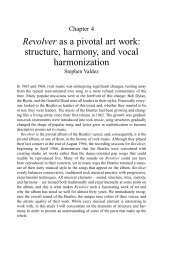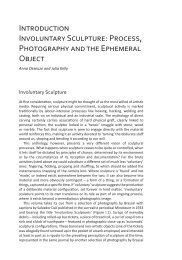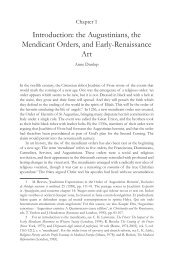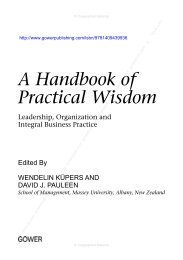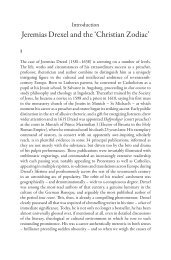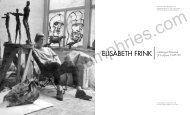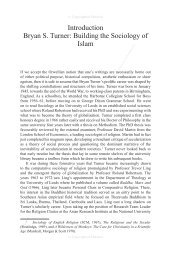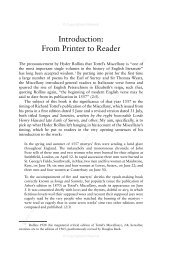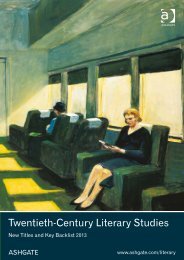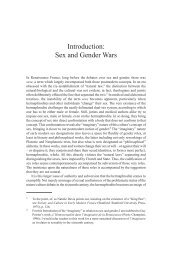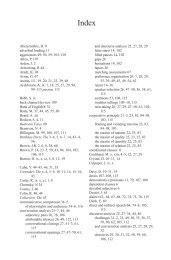The Baroque Composers - Ashgate
The Baroque Composers - Ashgate
The Baroque Composers - Ashgate
You also want an ePaper? Increase the reach of your titles
YUMPU automatically turns print PDFs into web optimized ePapers that Google loves.
<strong>The</strong><br />
<strong>Baroque</strong> <strong>Composers</strong><br />
5-Volume Series<br />
Series Editor: David Ledbetter, Royal Northern College of Music, UK<br />
5-Volume Set<br />
Special Offer<br />
See inside<br />
for details on<br />
how to save<br />
money!<br />
Our knowledge of music of the <strong>Baroque</strong> era has been transformed in recent decades,<br />
not least because of the revolution in performing styles and techniques. This series<br />
dedicates a volume to each of the central composers - Monteverdi, Purcell, Vivaldi,<br />
J.S. Bach and Handel - and brings together selected essays which are significant in<br />
terms of their contribution to the progress of thought in their field. <strong>The</strong>se include<br />
studies in biography, sources, analysis and genre, reception, performance and more,<br />
as relevant to each individual composer.<br />
Each volume is edited by a leading authority and includes a substantial introduction<br />
which outlines the main developments in recent scholarship, provides context for the<br />
selected essays and points the reader to other crucial items in the rich literature.<br />
This series makes readily available important articles from publications of restricted<br />
circulation that are difficult to access, and is invaluable for researchers and students<br />
keen to keep abreast of the immense development of musicology since the midtwentieth<br />
century.<br />
www.ashgate.com/reference
<strong>The</strong> <strong>Baroque</strong> <strong>Composers</strong><br />
NEW<br />
Monteverdi<br />
Edited by Richard Wistreich, Royal Northern<br />
College of Music, Manchester, UK.<br />
<strong>The</strong> field of Monteverdi studies has seen many groundbreaking<br />
contributions from musicologists in recent<br />
years. This collection of articles exemplifies the best of<br />
this scholarship in English and includes papers on a wide<br />
range of issues including some of the ‘big’ questions in<br />
the historiography and hermeneutics of early <strong>Baroque</strong><br />
music: musical representation of language; theory,<br />
analysis and genre; social, institutional, cultural and<br />
gender history; and performance practices.<br />
Contents and contributors include:<br />
Introduction<br />
Part I Text and Music:<br />
Monteverdi’s poetic choices,<br />
Nino Pirrotta<br />
Madrigal, monody, and Monteverdi’s ‘via naturale alla immitatione’,<br />
Gary Tomlinson<br />
Monteverdi’s mimetic art: ‘L’incoronazione di Poppea’,<br />
Ellen Rosand<br />
Resemblance and representation: towards a new aesthetic in the music of<br />
Monteverdi,<br />
Tim Carter.<br />
Part II <strong>The</strong>ory and Genre:<br />
Artusi, Monteverdi, and the poetics of modern music,<br />
Tim Carter<br />
Gendering modern music: thoughts on the Monteverdi–Artusi controversy,<br />
Suzanne G. Cusick<br />
Claudio Monteverdi’s Ordine novo, bello et gustevole: the canzonetta as dramatic<br />
module and formal archetype,<br />
Massimo Ossi<br />
Monteverdi’s three genera: a study in terminology,<br />
Barbara Russano Hanning.<br />
Part III Criticism, Analysis and History:<br />
Constructions of gender in Monteverdi’s dramatic music,<br />
Susan McClary<br />
<strong>The</strong> Platonic agenda of Monteverdi’s Seconda Practica: a case study from the eighth<br />
book of madrigals,<br />
Geoffrey Chew<br />
Monteverdi, two sonnets and a letter,<br />
Anthony Pryer<br />
Tacitus incognito: opera as history in L’incoronazione di Poppea,<br />
Wendy Heller.<br />
Part IV Institutional, Source and Performance Issues:<br />
Musicians at the court of Mantua during Monteverdi’s time: evidence from the<br />
payrolls,<br />
Susan Parisi<br />
Monteverdi’s Mantuan Orfeo: some new documentation,<br />
Iain Fenlon<br />
Transposition in Monteverdi’s Vespers of 1610: an ‘aberration’ defended,<br />
Andrew Parrott<br />
La Poppea Impasticciata or, who wrote the music to L’incoronazione (1643)?,<br />
Alan Curtis<br />
Monteverdi’s ‘Mass of Thanksgiving’ revisited,<br />
Jeffrey G. Kurtzman<br />
Name Index.<br />
includes 17 previously published journal articles<br />
January 2011 580 pages Hardback 978-0-7546-2902-3<br />
http://www.ashgate.com/isbn/9780754629023<br />
NEW<br />
Purcell<br />
Edited by Peter Holman, University of Leeds, UK<br />
<strong>The</strong> articles in this volume are a representative selection<br />
of the best scholarly writing on Purcell’s music. <strong>The</strong><br />
collection reflects the increase in new research stimulated<br />
by Purcell’s 300th anniversary in 1995 and the introduction<br />
explores the history of Purcell scholarship, reviews<br />
its present state, comments on the significance of the<br />
articles and offers a prospect for the future.<br />
Contents and contributors include:<br />
Introduction<br />
Part I Biography and Contexts:<br />
‘Only Purcell e’re shall equal Blow’,<br />
Bruce Wood<br />
<strong>The</strong> Italian connection: Giovanni Battista Draghi and Henry Purcell,<br />
Peter Holman<br />
Purcell’s stage singers and Purcell’s stage singers: a documentary list,<br />
Olive Baldwin and <strong>The</strong>lma Wilson<br />
‘He had the honour to be your master’: Lady Rhoda Cavendish’s music lessons with<br />
Henry Purcell,<br />
Michael Burden<br />
Letter from Aleppo: dating the Chelsea School performance of Dido and Aeneas,<br />
Bryan White.<br />
Part II Sources, Editing and Dissemination:<br />
Manuscript music in Purcell’s London,<br />
Robert Thompson<br />
Creating the corpus: the ‘complete keyboard music’ of Henry Purcell,<br />
Christopher Hogwood<br />
<strong>The</strong> Fairy Queen: a fresh look at the issues,<br />
Bruce Wood and Andrew Pinnock<br />
Newly discovered autograph keyboard music of Purcell and Draghi,<br />
Curtis Price<br />
Purcell’s ‘Rejoice in the Lord’, All Ways,<br />
Lionel Pike<br />
Robert Pindar, Thomas Busby, and the mysterious scoring of Henry Purcell’s<br />
‘Come Ye Sons of Art’,<br />
Rebecca Herissone.<br />
Part III Styles, Genres and Compositional Process:<br />
<strong>The</strong> technique and forms of Purcell’s sonatas,<br />
Michael Tilmouth<br />
Purcell’s extended solo songs,<br />
Margaret Laurie<br />
Purcell’s Laudate Ceciliam: an essay in stylistic experimentation,<br />
Martin Adams<br />
Purcell’s revisions to the funeral sentences revisited,<br />
Robert Shay<br />
Compositional choices in Henry Purcell’s Three Parts Upon a Ground,<br />
Peter Holman<br />
Composition as an act of performance: artifice and expression in Purcell’s sacred<br />
partsong Since God So Tender a Regard,<br />
Alan Howard<br />
‘Fowle originalls’ and ‘fayre writeing’: reconsidering Purcell’s compositional process,<br />
Rebecca Herissone.<br />
Part IV Performance, Performance Practice and Reception:<br />
<strong>The</strong> Shakespeare-Purcell Fairy Queen: a defence and recommendation,<br />
Roger Savage<br />
Continuity and tempo in Purcell’s vocal works,<br />
A. Margaret Laurie<br />
<strong>The</strong> first performance of Purcell’s Funeral Music for Queen Mary,<br />
Bruce Wood<br />
‘Or rather our musical Shakespeare’: Charles Burney’s Purcell,<br />
Richard Luckett<br />
Purcell debauch’d: the Dramatick Operas in performance,<br />
Michael Burden<br />
Name Index.<br />
Includes 23 previously published journal articles<br />
January 2011 576 pages Hardback 978-0-7546-2896-5<br />
http://www.ashgate.com/isbn/9780754628965<br />
All online orders receive a 10% discount!<br />
www.ashgate.com
5-Volume Set Special Offer: buy all volumes in the series and save money!<br />
Buying all 5 volumes in this series is your best option! It’s far more cost-effective because the set price already includes a generous discount.<br />
And, if you place your order via our website you will also benefit from an additional 10% discount.<br />
This is the way to make huge savings for your budget! See over for more details<br />
NEW<br />
Vivaldi<br />
Edited by Michael Talbot, Liverpool University, UK<br />
<strong>The</strong> articles selected for this volume form a representative<br />
selection of the best writing on Vivaldi from the last 30<br />
years, and include contributions from major figures in<br />
the field of Vivaldi research. Aspects covered include<br />
biography, Venetian cultural history, manuscript studies,<br />
genre studies and musical analysis. An introduction by<br />
Michael Talbot reviews the state of Vivaldi scholarship<br />
past and present and comments on the significance of the<br />
articles.<br />
Contents and contributors include:<br />
Introduction<br />
Part I Biographical Studies:<br />
<strong>The</strong> fortunes of Vivaldi biography, from Pincherle to the present,<br />
Michael Talbot<br />
Antonio Vivaldi e i Vivaldi,<br />
Gastone Vio<br />
Antonio Vivaldi prete,<br />
Gastone Vio<br />
Vivaldi dagli archivi di Mantova,<br />
Claudio Gallico<br />
I nove ‘principi di altezza’ corrispondenti di Vivaldi e la dedica enigmatica del<br />
Concerto RV 574. Alla ricerca dell’indirizzario perduto,<br />
Carlo Vitali<br />
Documenti inediti su Vivaldi a Roma,<br />
Fabrizio Della Seta<br />
Wenzel von Morzin as a patron of Antonio Vivaldi,<br />
Michael Talbot<br />
Vivaldi e il Teatro La Pergola a Firenzi: nuove fonti,<br />
William C. Holmes.<br />
Part II Source Studies:<br />
Towards a Vivaldi chronology,<br />
Paul Everett<br />
Vivaldi’s marginal markings: clues to sets of instrumental works and their chronology,<br />
Paul Everett<br />
Vivaldi at work: the autograph of the ‘Gloria’ RV 589,<br />
Paul Everett<br />
Vivaldi’s Quadro? <strong>The</strong> case of RV Anh. 66 reconsidered,<br />
Michael Talbot<br />
La famosa mano di Monsieur Roger: Antonio Vivaldi and his Dutch publishers,<br />
Rudolf Rasch<br />
Vivaldi and Lotti: two unknown borrowings in Vivaldi’s music,<br />
Kees Vlaardingerbroek.<br />
Part III Analytical and Genre Studies:<br />
Le opere giovanili di Antonio Vivaldi,<br />
Federico Maria Sardelli<br />
Vivaldi’s ‘Crucifixus’ in its descriptive and rhetorical context,<br />
Jasmin Cameron<br />
Formal structure in Vivaldi’s variation sets,<br />
Nicholas Lockey<br />
‘Die schwarze Gredel’, or the parallel minor key in Vivaldi’s instrumental music,<br />
Bella Brover-Lubovsky<br />
Ueber die Beziehungen zwischen einigen Concerto- und Sinfonia-Sätzen Vivaldis,<br />
Karl Heller<br />
<strong>The</strong> dramatic in Vivaldi’s cantatas,<br />
Colin Timms<br />
Vivaldi’s Serenatas: long cantatas or short operas?,<br />
Michael Talbot<br />
Antonio Vivaldi’s setting of Teuzzone: dramatic speech and musical image,<br />
Reinhard Strohm<br />
Name Index.<br />
includes 22 previously published journal articles<br />
January 2011 564 pages Hardback 978-0-7546-2884-2<br />
http://www.ashgate.com/isbn/9780754628842<br />
NEW<br />
Bach<br />
Edited by Yo Tomita, Queen’s University Belfast, UK<br />
Bach scholars frequently provide excellent examples<br />
of musicological scholarship, as demonstrated by the<br />
31 published articles selected for this volume. <strong>The</strong>se<br />
articles also represent a broad spectrum of the scholarly<br />
discussions on J.S. Bach’s life and works, and facilitate<br />
the on-going study of Bach’s creative genius.<br />
Contents and contributors include:<br />
Introduction<br />
Part I Life and Context:<br />
Johann Christoph Bach (1671–1721), ‘Organist und Schul<br />
Collega in Ohrdruf’, Johann Sebastian Bachs erster Lehrer,<br />
Hans-Joachim Schulze<br />
Johann Sebastian Bach als Schüler der Partikularschule zu St Michaelis in Lüneburg,<br />
oder Lüneburg eine Pflegstätte kirchlicher Musik,<br />
Wilhelm C. Junghans<br />
<strong>The</strong> musician versus the grammarian: an early storm warning,<br />
Paul S. Minear<br />
In defence of J.A. Scheibe against J.S. Bach,<br />
George J. Buelow<br />
J.S. Bach: new light on his faith,<br />
Christoph Trautmann<br />
Motive and motif in the church music of Johann Sebastian Bach,<br />
Robin A. Leaver.<br />
Part II Source Studies:<br />
Zum Wandel des Bach-Bildes. Zu Friedrich Blumes Mainzer Vortrag,<br />
Alfred Dürr<br />
Antwort von Friedrich Blume,<br />
Friedrich Blume<br />
Persönliches zur Geschichte der Jüngeren Bach-Forschung ( A personal message<br />
concerning the history of recent Bach scholarship),<br />
Arthur Mendel<br />
Yoshitake Kobayashi’s article ‘On the Chronology of the Last Phase of Bach’s Work<br />
– Compositions and Performances: 1736 to 1750’ – an analysis with translated<br />
portions of the original text,<br />
Gerhard Herz.<br />
Part III Genre Studies:<br />
Bach’s chorale cantatas,<br />
Alfred Dürr<br />
Neue ‘Texte zur Leipziger Kirchen-Music’,<br />
Wolf Hobohm<br />
Der Picander-Jahrgang,<br />
Klaus Häfner<br />
Bach und der Picander-Jahrgang – Eine Erwiderung,<br />
William H. Scheide<br />
Picander, der Textdichter von Bachs viertem Kantatenjahrgang. Ein neuer Hinweis,<br />
Klaus Häfner<br />
Eindeutigkeit und Mehrdeutigkeit in Picanders Kantatenjahrgangs-Vorbemerkung<br />
und im Werkverzeichnis des Nekrologs auf Johann Sebastian Bach,<br />
William H. Scheide<br />
Traces of the pre-history of Bach’s St John and St Matthew Passions,<br />
Arthur Mendel<br />
‘Et Incarnatus’ and ‘Crucifixus’: the earliest and the latest settings of Bach’s B-minor<br />
Mass,<br />
Christoph Wolff<br />
Friedrich Smend’s edition of the B-minor Mass by J.S. Bach,<br />
Georg von Dadelsen<br />
Universality in Bach’s B Minor Mass: a portrait of Bach in his final years,<br />
Yoshitake Kobayashi<br />
Zur Parodiefrage in Bachs h-Moll-Messe: Eine Bestandsaufnahme,<br />
Alfred Dürr<br />
<strong>The</strong> parody process in Bach’s music: an old problem reconsidered,<br />
Hans-Joachim Schulze<br />
Parody and theological consistency: notes on Bach’s A-Major Mass,<br />
Robin A. Leaver<br />
Bach the progressive: observations on his later works,<br />
Robert L. Marshall<br />
Bach: progressive or conservative and the authorship of the Goldberg Aria,<br />
Frederick Neumann<br />
Postscript,<br />
Robert L. Marshall<br />
Psalm and the Well-Tempered Clavier II: revisiting the old question of Bach’s source of<br />
inspiration,<br />
Yo Tomita.<br />
Part IV Performance Practice:<br />
Performance practice of Bach’s cantatas: original performance material; original<br />
rehearsals: original performance forces: original performance style: conclusions for<br />
modern performance,<br />
Alfred Dürr<br />
Bach’s chorus: a preliminary report,<br />
Joshua Rifkin<br />
Does ‘well-tempered’ mean ‘equal-tempered’?,<br />
Rudolf Rasch<br />
Some performance problems of Bach’s unaccompanied violin and cello works,<br />
Frederick Neumann<br />
Name Index; Works Index.<br />
includes 31 previously published journal articles<br />
february 2011 612 pages Hardback 978-0-7546-2891-0<br />
http://www.ashgate.com/isbn/9780754628910
5-Volume Set ISBN: 978-0-7546-2903-0<br />
NEW<br />
Handel<br />
Edited by David Vickers, Royal Northern College of Music, Manchester, UK<br />
This anthology brings together the best of recent scholarly literature devoted to Handel selected from diverse sources including specialist yearbooks,<br />
festschrifts, newsletters, conference proceedings, exhibition catalogues and journals and consist of different kinds of studies of the composer’s<br />
biography, operatic career, singers, librettists, as well as studies of his relationship with the music of other composers.<br />
Contents and contributors include:<br />
Introduction<br />
Part I Biographical Aspects:<br />
Mythistorica Handeliana,<br />
Charles Cudworth<br />
Organ playing in the Lateran and other remembrances on Handel: a report in the<br />
Voiage Historique of 1737,<br />
Ursula Kirkendale<br />
Handel and the feuding royals,<br />
Thomas McGeary<br />
Handel’s art collection,<br />
Alison Meyric Hughes and Martin Royalton-Kisch<br />
Joseph Goupy and George Frideric Handel: from professional triumphs to personal<br />
estrangement,<br />
Ellen T. Harris<br />
Handel’s ill health: documents and diagnoses,<br />
David Hunter.<br />
Part II Handel and the Opera House:<br />
Handel’s Haymarket <strong>The</strong>ater,<br />
Mark W. Stahura<br />
Box office reports for five operas mounted by Handel in London, 1732–1734,<br />
Judith Milhous and Robert D. Hume<br />
Handel’s 1736 performances of Ariodante,<br />
Donald Burrows.<br />
Part III Case Studies of Handel’s Compositions:<br />
Benedetto Pamphilj as librettist: Mary Magdalene and the harmony of the spheres in<br />
Handel’s Il trionfo del Tempo e del Disinganno,<br />
Huub van der Linden<br />
Psychological realism in Il trionfo del tempo e del disinganno,<br />
Ruth Smith<br />
A newly discovered Water Music source,<br />
Terence Best<br />
Handel and the confus’d shepherdess: a case study of stylistic eclecticism,<br />
Graham Cummings<br />
Handel, Jennens and Saul: aspects of a collaboration,<br />
Anthony Hicks<br />
From Milton to Handel: the transformation of Milton’s L’Allegro and Il Penseroso into a<br />
musical work for concert performance in the London theatres,<br />
Donald Burrows<br />
Some thoughts on musical organization in L’Allegro il Penseroso ed il Moderato,<br />
Graydon Beeks<br />
Part IV Handel’s Performers:<br />
<strong>The</strong> unpublished Senesino,<br />
Elisabetta Avanzati<br />
From Rinaldo to Orlando, or Senesino’s path to madness,<br />
Melania Bucciarelli<br />
Francesca Cuzzoni and Faustina Bordoni: the rival<br />
queens?,<br />
Suzana Ograjenšek<br />
Marie Sallé as muse: Handel’s music for mime,<br />
Sarah McCleave<br />
John Beard: the tenor voice that inspired Handel,<br />
Neil Jenkins.<br />
Part V Librettists:<br />
Handel’s relations with the librettists of his operas,<br />
Winton Dean<br />
<strong>The</strong> achievments of Charles Jennens (1700–1773),<br />
Ruth Smith<br />
George Frideric Handel’s 1749 letter to Charles Jennens,<br />
William D. Gudger<br />
Thomas Morell and his letter about Handel,<br />
Ruth Smith.<br />
Part VI Handel and Other <strong>Composers</strong>:<br />
Handel’s years as an apprentice to Reinhard Keiser at the Gänsemarkt opera house<br />
(1703–1705),<br />
Hans Joachim Marx<br />
Handel and Alessandro Scarlatti,<br />
Winton Dean<br />
Handel and the shepherds of Ansbach,<br />
John H. Roberts<br />
What did Handel learn from Steffani’s operas?,<br />
Colin Timms.<br />
Part VII Performing Handel:<br />
Who does what, when? On the instrumentation of the basso continuo and the use of<br />
the organ in Handel’s English oratorios,<br />
Donald Burrows<br />
Staging a Handel opera,<br />
Andrew V. Jones<br />
Name Index.<br />
includes 31 previously published journal articles<br />
January 2011 594 pages Hardback 978-0-7546-2885-9<br />
http://www.ashgate.com/isbn/9780754628859<br />
order online for a 10% discount: www.ashgate.com<br />
Order Reference: S1EDH<br />
Quantity title isbn Price<br />
____ Monteverdi_ __________________________________<br />
____ Purcell_ ______________________________________<br />
____ Vivaldi________________________________________<br />
____ Bach_________________________________________<br />
____ Handel_______________________________________<br />
____ 5 Volume Set (special price) _ ___________________<br />
978-0-7546-2902-3______<br />
978-0-7546-2896-5______<br />
978-0-7546-2884-2______<br />
978-0-7546-2891-0______<br />
978-0-7546-2885-9______<br />
978-0-7546-2903-0______<br />
Prices, publication dates and contents<br />
shown in this leaflet are correct at the<br />
time of going to press but are subject<br />
to change without notice. Details of<br />
forthcoming titles are necessarily<br />
provisional.<br />
1/2011<br />
Worldwide orders:<br />
by post: Bookpoint Limited<br />
<strong>Ashgate</strong> Publishing Direct Sales<br />
130 Milton Park, Abingdon ,<br />
Oxon, OX14 4SB, UK<br />
by phone: +44 (0)1235 827730<br />
by fax: +44 (0)1235 400454<br />
by email: ashgate@bookpoint.co.uk<br />
Orders from North & South<br />
America:<br />
<strong>Ashgate</strong> Publishing Company<br />
PO Box 2225<br />
Williston , VT 05495-2225, USA<br />
by phone: +1 800 535-9544<br />
by fax: +1 802 864-7626<br />
by email: orders@ashgate.com


